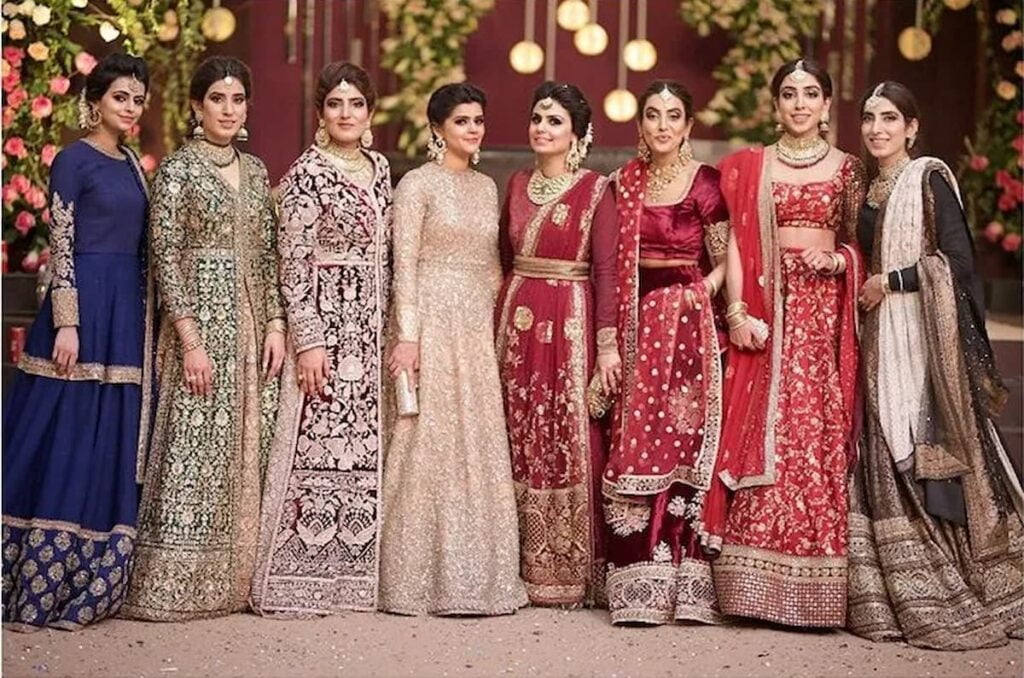Choosing a wedding dress is a deeply personal and symbolic decision, often influenced by cultural, religious, and family traditions. It’s a gown that not only reflects the bride’s style and personality but also honours the values and beliefs that are important to her. Asian bridal wear often incorporates religious symbols and colours, reflecting cultural traditions and emphasising modesty and respect for tradition.
From modesty requirements to symbolic colours and cultural symbols, the choice of a wedding dress carries profound significance. It’s a garment that signifies the beginning of a new chapter, blending tradition with personal expression. Understanding and respecting these aspects can guide the selection process, ensuring that the dress not only looks beautiful but also resonates with the deeper meaning of the wedding ceremony.
Symbolism:
Symbolism plays a significant role in many religious traditions when choosing a wedding dress. For example, white is often associated with purity and innocence in Western cultures, symbolising the bride’s commitment to a new life with her partner. In some cultures, red symbolises auspiciousness and joy, while gold signifies prosperity and good fortune. Embroidery or motifs on the dress may hold religious significance, representing blessings, prayers, or cultural heritage. The style of the dress, such as modesty requirements or specific silhouettes, can also reflect religious values and teachings. Ultimately, the symbolism in a wedding dress serves to deepen the spiritual meaning of the marriage ceremony, connecting the bride to her faith and cultural identity.
Colour of the Dress:
The colour of a wedding dress can hold significant religious meaning and varies widely across different cultures and traditions. In Western cultures, white is often associated with purity and innocence, symbolising the bride’s new beginning. However, in many Eastern cultures, red is the traditional colour for brides, symbolising luck, joy, and prosperity. Other colours, such as gold, blue, or green, may also hold religious significance in certain traditions. Brides need to consider the cultural and religious significance of colours when choosing their wedding dress, as it can add a deeper layer of meaning to their special day.
Body Shape:
Body shape considerations are important when choosing a wedding dress, and these considerations can align with religious aspects as well. Many religious traditions emphasise modesty, which can influence the style of dress chosen. For example, a bride with a pear-shaped body might opt for an A-line dress, which is flattering and modest. Similarly, a bride with an hourglass figure might choose a dress that accentuates her waist while still adhering to modesty requirements. Understanding how different dress styles complement various body shapes can help brides select a gown that not only meets religious guidelines but also makes them feel confident and beautiful on their special day.
Length of a Wedding Dress:
The length of a wedding dress is a significant consideration in many religious traditions. Modesty is often a key factor, with many cultures and faiths preferring dresses that cover the legs completely, sometimes even extending to the floor. For example, in some Muslim and Orthodox Jewish ceremonies, brides may wear floor-length gowns or dresses with a modest train to adhere to religious guidelines regarding modesty and femininity. Additionally, in Hindu weddings, brides may wear a saree or lehenga that covers the legs fully as a sign of respect and modesty. Understanding the expectations of dress length in your religious tradition can help ensure that your choice of gown aligns with these cultural and spiritual values.
Fit of Dress:
The fit of a wedding dress is a crucial consideration, especially when viewed through the lens of religious aspects. Many religious traditions emphasise modesty and decency in attire, which often translates to a dress that fits comfortably without being overly revealing. The dress should not only adhere to the bride’s style but also respect the guidelines set forth by her religious community. It should allow for ease of movement, which is particularly important during ceremonies that involve kneeling, sitting, or other physical activities. A well-fitted dress not only enhances the bride’s comfort but also ensures that she feels confident and respectful of her religious traditions on her special day.

Conclusion:
The choice of a wedding dress is a deeply meaningful decision that encompasses religious and cultural considerations. From modesty requirements to symbolic colours and cultural symbols, each element of the dress carries significance. By honouring these traditions, brides can create a dress that not only reflects their style but also respects and celebrates their religious and cultural heritage. The wedding dress serves as a symbol of unity, blending tradition with personal expression to create a garment that is both beautiful and meaningful. Ultimately, choosing a wedding dress is a way to honour the past while embracing the future, symbolising the beginning of a new journey filled with love and commitment.
Also Read: Why Are Indian Women’s Dresses Gaining Popularity?

